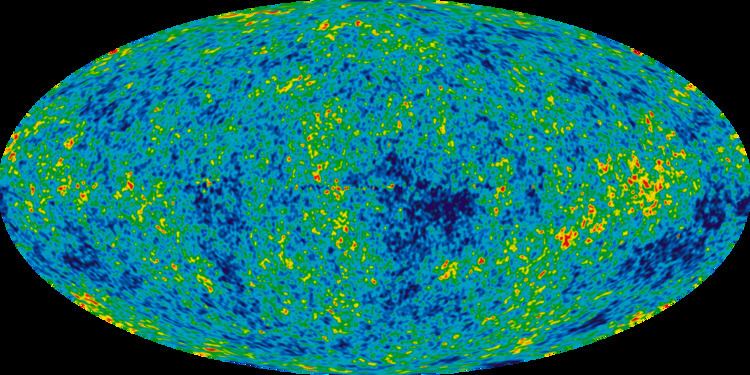 | ||
The thermodynamics of the universe is dictated by which form of energy dominates it - relativistic particles which are referred to as radiation, or non-relativistic particles which are referred to as matter. The former are particles whose rest mass is zero or negligible compared to their energy, and therefore move at the speed of light or very close to it; the latter are particles whose kinetic energy is much lower than their rest mass and therefore move much slower than the speed of light. The intermediate case is not treated well analytically.
Contents
Energy density in the expanding universe
If the universe is expanding adiabatically then it will satisfy the first law of thermodynamics:
where
One then finds an equation for the energy density
where in the last equality we used the fact that the total volume of the universe is proportional to
In fact this equation can be directly obtained from the equations of motion governing the Friedmann-Lemaître-Robertson-Walker metric: by dividing the equation above with
In the comoving coordinates,
For radiation
For matter
This can be understood as follows: For matter, the energy density is equal (in our approximation) to the rest mass density. This is inversely proportional to the volume, and is therefore proportional to
From this discussion it is also obvious that the temperature of radiation is inversely proportional to the scale factor
Rate of expansion of the universe
Plugging this information to the Friedmann-Lemaître-Robertson-Walker equations of motion and neglecting both the cosmological constant
One can further show that the universe was radiation-dominated as long as the energy density was of the order of 10 eV to the fourth, or higher. Since the energy density keeps going down, this was no longer true when the universe was 70,000 years old, when it became matter dominant.
In the universe today, matter is mainly in forms of galaxies and dark matter, while the radiation is the cosmic microwave background radiation, the cosmic neutrino background (if the neutrino rest mass is high enough then the latter is formally matter), and finally, mostly in the form of dark energy.
Dark energy and cosmic inflation
Dark energy is a hypothetical form of energy that permeates all of space and its negative pressure coincides with an acceleration in the expansion of the universe. Positive pressure coincides with a deceleration as does the gravity of energy and mass. There is no known cause and effect in fundamental physics, so it is not assumed the pressures or gravity "cause" a reduction or acceleration in the expansion of the universe, nor vice versa. For example, the energy in the gravitional field of the universe that coincides with its expansion is equal and opposite to the mass energy of the universe and it is not assumed (and the equations do not indicate) that the expansion created the positive mass energy and negative gravitational energy, nor vice versa.
According to the equation above,
Thus the more negative the pressure is, the less the energy density reduces as the universe expands. In other words, Dark energy dilutes less than any other form of energy, and will therefore eventually dominate the universe, as all other energy densities gets diluted faster with the expansion of the universe.
In fact, if the dark energy is created by a cosmological constant or a constant scalar field, then its pressure is minus its energy density
Dark energy is usually assumed to be the Casimir energy of the vacuum, with possible contributions from the energy density of scalar fields which has a non-zero value at the vacuum. It may be that this field can decay at some time in the distant future, leading to a new vacuum state, different than the one we are living in. This is a phase transition, where the dark energy is reduced and huge amounts of energy in conventional forms (i.e. particles) are produced.
Such a series of events is in fact thought to have already occurred in the early universe, where first a cosmological constant much larger than the present one came to dominate the universe, bringing about cosmic inflation. At the end of this epoch, a phase transition occurred where the cosmological constant was reduced to its present value and huge amounts of energy where produced, from which all the radiation and matter of the early universe came about.
